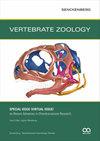A multitude of spots! Five new microendemic species of the Cnemaspis gracilis group (Squamata: Gekkonidae) from massifs in the Shevaroy landscape, Tamil Nadu, India
IF 2.4
2区 生物学
Q1 ZOOLOGY
引用次数: 3
Abstract
South Asian Cnemaspis are one of the most diverse clades of gekkonids in South Asia with their highest diversity in the Western Ghats and Sri Lanka. These geckos include only a few nocturnal species and are largely diurnal or cathemeral and restricted to relatively cool habitats. One of the prominently diurnal subgroups in South Asian Cnemaspis is the bangara clade, which includes six species distributed in southern India on the eastern slopes of the Western Ghats, the southern Eastern Ghats and Palghat Gap. In this paper, we describe five more species of the bangara clade from the Shevaroyan landscape, including three from Kollimalai and one each from Yercaud and Pachaimalai, all in Tamil Nadu. These new species show 4.6–19.7 % uncorrected sequence divergence on the mitochondrial ND2 gene from each other and known species of the bangara clade and are morphologically diagnosable in body size, the number of paravertebral tubercles between limb insertions, the number of dorsal tubercle rows, the number of ventral scale rows across the belly, the number of femoral and precloacal pores and poreless scales separating these series, and aspects of colouration. The discovery of these five new species adds to the growing discoveries of cool-adapted species in southern India outside the Western Ghats and highlights the role of sky-islands in diversification. The Shevaroyan landscape shows high levels of microendemism with eight species distributed in an area of < 2000 km2, and all these species restricted to much smaller areas of actual distribution. With an area of < 500 km2 respectively, the massif of Pachaimalai has a single endemic and the massifs of Yercaud and Kollimalai have three endemic Cnemaspis species each.好多地方!印度泰米尔纳德邦Shevaroy地区山丘上细刺蛙群的五个新的微生态系统物种(Squamata:Gekkonidae)
南亚Cnemaspis是南亚gekkonids最具多样性的分支之一,其多样性最高的分支位于西高止山脉和斯里兰卡。这些壁虎只包括少数夜间活动的物种,主要是日间活动或猫猫活动,并局限于相对凉爽的栖息地。南亚Cnemaspis的一个显著的昼夜亚群是bangara分支,它包括六个物种,分布在印度南部的西高止山脉、东高止山脉南部和帕尔加特峡的东坡。在本文中,我们描述了Shevaroyan景观中bangara分支的另外五个物种,其中三个来自Kollimalai,一个来自Yercaud和Pachaimalai,都在泰米尔纳德邦。这些新物种在线粒体ND2基因上显示出4.6-19.7%的未校正序列差异,与班加拉支的已知物种不同,在体型、肢体插入之间的椎旁结节数量、背侧结节行数、腹部腹侧鳞片行数、,股骨和股骨前孔的数量以及分隔这些系列的无孔鳞片,以及着色方面。这五个新物种的发现为印度南部西高止山脉以外越来越多的冷适应物种的发现增添了新的内容,并突出了天空岛屿在多样化中的作用。Shevaroyan景观显示出高度的微生态系统,有8种物种分布在<2000平方公里的区域内,所有这些物种都局限于较小的实际分布区域。Pachaimalai地块面积分别小于500平方公里,有一个特有种,Yercaud和Kollimalai地块各有三个特有种。
本文章由计算机程序翻译,如有差异,请以英文原文为准。
求助全文
约1分钟内获得全文
求助全文
来源期刊

Vertebrate Zoology
ZOOLOGY-
CiteScore
4.00
自引率
19.00%
发文量
42
审稿时长
>12 weeks
期刊介绍:
Research fields covered by VERTEBRATE ZOOLOGY are taxonomy, morphology, anatomy, phylogeny (molecular and morphology-based), historical biogeography, and palaeontology of vertebrates.
 求助内容:
求助内容: 应助结果提醒方式:
应助结果提醒方式:


